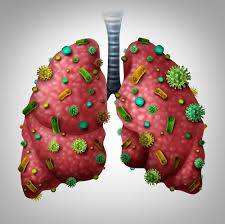Lung infections can be caused by various pathogens, lead to a range of signs and symptoms, have various effects, and require different solutions. Here are 20 causes, signs, effects, and solutions related to lung infections:
**Causes of Lung Infections:**
1. **Bacteria:** Common bacteria causing lung infections include Streptococcus pneumoniae and Haemophilus influenzae.
2. **Viruses:** Influenza viruses, rhinoviruses, and respiratory syncytial virus (RSV) can lead to lung infections.
3. **Fungi:** Aspergillus and Candida are examples of fungi causing lung infections.
4. **Mycobacteria:** Mycobacterium tuberculosis causes tuberculosis (TB).
5. **Parasites:** Parasitic lung infections, like those caused by lung flukes, are less common.
6. **Airborne Transmission:** Infections can be spread through respiratory droplets from coughs and sneezes.
7. **Contaminated Surfaces:** Touching surfaces contaminated with pathogens and then touching the face can lead to infections.
8. **Close Contact:** Being in close proximity to an infected person.
9. **Weakened Immune System:** Immunosuppression increases susceptibility.
10. **Crowded Environments:** Living in crowded areas with poor ventilation can promote transmission.
11. **Travel to Endemic Areas:** Visiting regions with high infection rates.
12. **Chronic Lung Conditions:** Such as chronic obstructive pulmonary disease (COPD) or bronchiectasis.
13. **Recent Respiratory Infections:** Previous infections can weaken the respiratory system.
14. **Smoking:** Smoking damages the respiratory tract, making it more susceptible.
15. **Medical Procedures:** Invasive medical procedures can introduce pathogens.
16. **Chemotherapy:** Cancer treatments can weaken the immune system.
17. **HIV/AIDS:** HIV compromises the immune system's ability to fight infections.
18. **Cystic Fibrosis:** Patients with CF have thicker mucus that can trap pathogens.
19. **Age:** Very young and elderly individuals are more vulnerable.
20. **Poor Hygiene:** Lack of handwashing and respiratory hygiene.
**Signs and Symptoms of Lung Infections:**
1. **Cough:** Often with mucus production.
2. **Fever:** Elevated body temperature.
3. **Shortness of Breath:** Difficulty breathing, especially with exertion.
4. **Chest Pain:** Discomfort or pressure in the chest.
5. **Fatigue:** Feeling unusually tired.
6. **Chills:** Shivering and feeling cold.
7. **Wheezing:** High-pitched whistling sounds during breathing.
8. **Sputum Production:** Coughing up thick or colored mucus.
9. **Body Aches:** Generalized muscle pain.
10. **Headache:** Pain or discomfort in the head.
11. **Sore Throat:** Irritation and pain in the throat.
12. **Loss of Appetite:** Reduced interest in eating.
13. **Nasal Congestion:** Blockage of nasal passages.
14. **Runny Nose:** Excess nasal discharge.
15. **Malaise:** A general feeling of unwellness.
16. **Rapid Heart Rate:** Increased pulse rate.
17. **Confusion:** Disorientation or altered mental state in severe cases.
18. **Blue Lips or Fingernails:** Cyanosis, a sign of low oxygen levels.
19. **Frequent Respiratory Infections:** Recurrent lung infections.
20. **Pleuritic Pain:** Chest pain worsened by deep breaths.
**Effects of Lung Infections:**
1. **Lung Damage:** Inflammation and scarring in the lungs.
2. **Pneumonia:** Severe lung infection with consolidation of lung tissue.
3. **Bronchitis:** Inflammation of the bronchial tubes.
4. **Respiratory Distress:** Difficulty breathing, especially in severe cases.
5. **Hypoxia:** Low oxygen levels in the body.
6. **Secondary Infections:** Increased susceptibility to other infections.
7. **Pulmonary Fibrosis:** Scarring of lung tissue.
8. **Bronchiectasis:** Permanent enlargement of airways.
9. **Respiratory Failure:** In severe cases.
10. **Sepsis:** Systemic infection affecting multiple organs.
11. **Lung Abscess:** A cavity filled with pus in the lung.
12. **Empyema:** Accumulation of infected fluid around the lung.
13. **Lung Cavities:** Hollow spaces within the lung.
14. **Pleurisy:** Inflammation of the pleura (lining around the lungs).
15. **Septic Shock:** Life-threatening condition due to infection.
16. **Chronic Respiratory Symptoms:** Persistent cough and breathing problems.
17. **Hospitalization:** Often required for severe cases.
18. **Complications:** Such as kidney or heart problems.
19. **Psychological Impact:** Anxiety and depression.
20. **Death:** In severe and untreated cases.
**Solutions for Lung Infections:**
1. **Antibiotics:** For bacterial lung infections.
2. **Antiviral Medications:** For viral lung infections.
3. **Antifungal Drugs:** For fungal lung infections.
4. **Antiparasitic Medications:** For parasitic lung infections.
5. **Rest and Hydration:** Adequate rest and fluid intake.
6. **Fever Management:** With over-the-counter medications.
7. **Pulmonary Rehabilitation:** For symptom management and recovery.
8. **Oxygen Therapy:** To improve oxygen levels in the blood.
9. **Ventilation Support:** Mechanical ventilation for severe cases.
10. **Respiratory Therapy:** Breathing exercises and treatments.
11. **Vaccination:** Preventive vaccines, especially for influenza and pneumonia.
12. **Handwashing:** Good hand hygiene to prevent transmission.
13. **Infection Control Measures:** In healthcare settings.
14. **Isolation:** To prevent the spread of contagious infections.
15. **Smoking Cessation:** To reduce lung damage.
16. **Environmental Hygiene:** Clean and sanitize surroundings.
17. **Nutritional Support:** A balanced diet for recovery.
18. **Antipyretics:** To reduce fever.
19. **Mucolytics:** Medications to loosen mucus.
20. **Early Detection and Treatment:** Seek medical care promptly.


